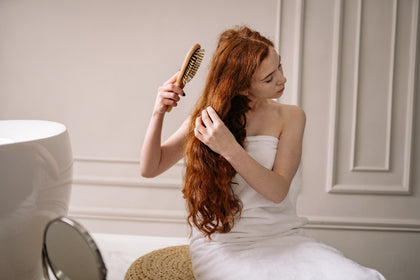Tangled hair can be frustrating at best, but hopelessness can set in when your strands are matted. However, before you toss your comb in the trash and cut off your matted locks, take a deep breath.
VEGAMOUR spoke with a professional stylist for tips to get those tangles and mats to unravel. Plus, find out what shampoo and conditioner you should use to get silky, shiny hair.
Tangles vs. Mats: What's the Difference?
Tangles, or hair knots, can occur in all types of hair. Tangles occur when hair strands become intertwined, creating a small knot. Tangles can happen due to friction between your hair and a surface, such as when you're sleeping. Tangles can also happen more easily in brittle hair that's damaged and dry or hair that has lengths that extend past the shoulders.
You can usually remove knots easily with a few picks of a small comb. But be gentle; yanking and breaking your strands can weaken your hair and make it more likely to tangle in the future.
If a knot is wider than the end of your fine-toothed comb, you might have a hair mat, which isn't so easily removed. A hair mat is when more hairs have become intertwined, forming a dense clump of tangles. Removing mats takes a special technique that's time-consuming. However, if done correctly, it can save you from having to cut out the hair mats.
It's best to consult with a hair professional who is experienced in removing hair mats and knows where to "snip" if a mat needs to be cut to get the clump to release.
Hair mats form for several reasons:
- Neglect: The hair needs more regular brushing, conditioning and detangling.
- Damage: If your hair is really mushy when it's wet and brittle when dry, it's a good indicator it's overprocessed due to chemical treatments. Therefore, it may tangle more and mat easily.
- Specific hair types or textures: Coily hair, very fine hair, children's hair and heavily textured hair might mat more easily.
- Specific hairstyles: Some hairstyles create mats on purpose for strength, such as dreads. These are usually removed by cutting when you're done wearing them and want to try a different style.
Shop: Non-Toxic Hair Products for Healthy, Shiny Hair
A Hairstylist's Detangling Process
VEGAMOUR spoke with Jason Tyler, professional hairstylist at Macho Hairstyles, for his tips on detangling matted hair.
"Detangling your hair is a necessary step when you want to style it," said Tyler. "It can
be frustrating and time-consuming, but there are a few things that you can do to make the process easier. The first thing to do is to use a gentle shampoo or conditioner that will not strip the natural oils from your hair. This will help keep your hair healthy and less prone to tangles in the future."
Tyler also shared his step-by-step process of detangling, which involves working the hair strands a little at a time, working the tangles out toward the ends, then midshafts, then from roots to tips. Although tedious, this is the only way to remove all knots and tangles from the hair.
How to Deal With Matted Hair
The process of dealing with mats is similar to detangling smaller knots but will take considerably longer. Here's how.
-
Test a strand of hair to see how the texture changes if you wet it. If the hair becomes mushy when wet, then you must detangle the hair dry. (In some cases, wetting hair can actually make mats worse, so if you're struggling, call your stylist for help.)
-
If the hair slips better when wet, apply some coconut oil or leave-in conditioner as you work.
-
Work the mats out from the bottom, like with knots, a few strands at a time, in small sections with a wide-tooth comb. As you work to free the tangles, you may notice lots of loose strands work their way out. These are usually fallen hairs that are released at the end of their natural life cycle and become trapped in the hair.
-
Avoid pulling and yanking, which can break the hair strands.
-
See a professional hairstylist if you're struggling with super-matted hair. The stylist might be able to avoid cutting out the entire matted area and save some of your hair.
See: Comb vs. Brush — When and How to Use Each
De-Matting Children's Hair
Children's hair seems especially prone to severe tangles. This may be due to some children having a sensitive scalp or wriggly demeanor that prevents regular detangling sessions, but it also has a lot to do with the fine and more delicate textures of their hair.
If your child is patient and still enough, you can try to pick through a mat on your own with a wide-tooth comb, working from the bottom. To help loosen the strands, spray the mat with a mixture of water and detangling conditioner that you mix yourself and put in a clean spray bottle or use a pre-mixed detangling solution.
To prevent tangles and mats in the future, regularly use a detangling spray after shampooing and conditioning and comb through the hair thoroughly with a wide-tooth comb. Also, regularly brush your child's hair to keep it free of mats and tangles.
Read: How to Get Glitter Out of Hair
When Hair Is Too Matted to Detangle
Occasionally, matted hair cannot be detangled. Severely matted hair may be clumped to the point of "sealing" together into a mass of strands. When this happens, your stylist may recommend cutting out a few pieces to release the mat and then proceeding with detangling measures to release the rest of the matted hair.
Read: 10 Reasons Your Hair Gets Tangled So Easily
Other Tips for Tangle-Free, Mat-Free Hair
Dealing with snarled and knotted hair is never fun. The good news is that you can avoid tangles and mats in your hair for the most part with the following tips:
- Get regular trims to remove split ends and damaged hair.
- Use a moisturizing and gentle shampoo and conditioner. VEGAMOUR recommends using the GRO Revitalizing Shampoo & Conditioner Kit for all hair types to help protect your hair and keep it from becoming dry or damaged.
- Provide "slip" on wet hair by using detangling products like a leave-in conditioner to smooth out the hair cuticles and provide a slick surface on the outside of the hair.
- Release smaller hair knots with a fine-tooth comb when detangling dry hair.
- Routinely deep condition your strands with a moisturizing conditioner to avoid mats. Coconut oil and shea butter are two at-home deep conditioners that can be used on wet hair or damp hair to provide "slip," preventing knotty hair. Olive oil may moisturize but doesn't provide the slippage you need for detangling. Use a wide-tooth comb to distribute the oils from the scalp to the tips of hair. Leave the oil on for a half-hour, and rinse with tepid water.
- Protect your mane while you slumber by using silk pillowcases that don't create friction, which can help prevent tangles even while you sleep. As an alternative, you can also tie your hair with a silk scarf or wear a silky nightcap.
- Avoid heavy chemical processing that can damage the hair.
- Avoid excessive heat styling that can damage the hair.
Protect Your Hair From Mats With Proper Care
The first step in preventing hair tangles and mats is prevention. Treat your hair gently and avoid chemical processes and excessive heat styling. Also, use natural hair care products that are free of sulfates and other chemicals to protect your hair while moisturizing it. It's also important to regularly comb and brush your hair. Finally, if your hair does become tangled, deal with the tangles right away to avoid mats forming.
#include-related-slider#
More From VEGAMOUR
- How to Strengthen Your Hair
- Why Does My Bottom Layer of Hair Get So Tangled?
- How to Detangle Hair With Minimal Damage
- How to Keep Your Hair From Getting Matted While Sleeping
Photo credit: Yan Krukov/Pexels



















